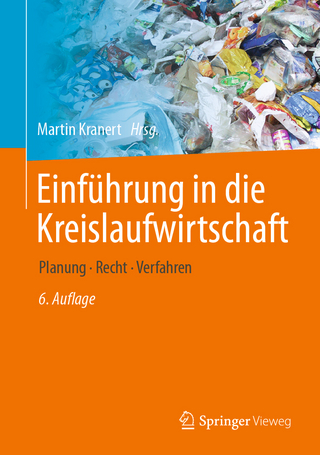
An Introduction to Agroforestry
Springer International Publishing (Verlag)
978-3-030-75360-3 (ISBN)
Agroforestry - the practice of growing trees and crops in interacting combinations - is recognized the world over as an integrated approach to sustainable land-use. Agroforestry systems, being multifunctional, facilitate not only the production of food and wood products but also provide a variety of ecosystem services such as climate-change mitigation, biodiversity conservation, and soil quality improvement.
Agroforestry research has made rapid strides since organized efforts started in the late 1970s. Today, a vast body of scientific knowledge and an impressive array of publications on agroforestry are available. Four World Congresses on Agroforestry conducted once every five years since 2004 have brought together the global community of agroforestry professionals and practitioners to share and discuss the emerging trends and paradigm shifts in this field. The fifth Congress is scheduled to be held in Québec, Canada.
However, a comprehensive college-level textbook incorporating these research findings did not exist until this book was first published. The first edition of this book in 1993 (Nair, P. K. R., 1993) is out of print and somewhat dated. This revised edition, with emphasis on the scientific developments during the past more than four decades, addresses this long-felt need.
lt;p> P. K. Ramachandran Nair, Distinguished Professor (Emeritus) at the University of Florida, is a pioneer in the academic field of agroforestry. He has made outstanding contributions to the development of the subject worldwide during the past 50 years such that the name PK Nair has become almost synonymous with agroforestry. Nair started his career as a multiple cropping agronomist at the plantation (tree) crops research institute in his native Kerala, India. In 1978 he became a founding member and a lead scientist of ICRAF (World Agroforestry), a CGIAR center, in Kenya. He joined the University of Florida in 1987, where he taught agroforestry and conducted and coordinated research in the subject for 32 years, and retired to Emeritus status in 2019. Nair holds six doctoral degrees - two earned and four honoris causa - and has worked in five continents. He is a Fellow of the American Association for the Advancement of Science, American Society of Agronomy, Crop Science Society of America, Soil Science Society of America, and the National Academy of Agricultural Sciences, India. His numerous other recognitions include the IUFRO Scientific Achievement Award, Research Award of the Society of American Foresters, Fulbright Distinguished Chair Award, and the Humboldt Prize, Germany.
B. Mohan Kumar, Vice-Chancellor of Arunachal University of Studies, India, is a leading researcher in agroforestry. Earlier, he held several leadership positions in India such as the Assistant Director General (Agronomy, Agroforestry & Climate Change), ICAR; Professor and Dean (Ecology & Environment Studies), Nalanda Univ; and Associate Dean (Forestry), Kerala Agric Univ. He also held visiting professorships at the Univ of Missouri, USA; Univ of Toulouse (CNRS Visitor); Bangor Univ, UK (Erasmus Mundus Scholar); Univ of Tokyo, Japan (IR3S Visiting Fellow); Univ of Florida, USA (Fulbright Award); Tokyo Univ of Agric & Tech, Japan (JSPS Scholar); Utah State Univ, USA (USAID Sponsorship); and several universities in Indonesia. He has published extensively on agroforestry and has received the first Dr. KG Tejwani Award for Excellence in Agroforestry Research & Development in India. Kumar is an Elected Fellow of the National Academy of Sciences, India; National Academy of Agricultural Sciences, India; National Institute of Ecology, India; and the Kerala Academy of Sciences.
Part 1. INTRODUCTION.- Chapter 1. Historical Developments: The Coming of Age of Agroforestry.- Chapter 2. Definition and Concepts of Agroforestry.- Chapter 3. Classification of Agroforestry Systems.- Chapter 4. Global Distribution of Agroforestry Systems.- Part 2. AGROFORESTRY SYSTEMS AND PRACTICES.- Chapter 5. Shifting Cultivation and Taungya.- Chapter 6. Tropical Alley Cropping and Improved Fallows.- Chapter 7. Tropical Homegardens.- Chapter 8. Shaded Perennial Agroforestry Systems.- Chapter 9. Silvopastoral Systems in the Tropics and Subtropics.- Chapter 10. Agroforestry in the Temperate Zone.- Chapter 11. Other Agroforestry Systems and Practices.- Part 3. BIOPHYSICAL FOUNDATIONS OF AGROFORESTRY: PLANT PRODUCTIVITY.- Chapter 12. General Principles of Plant Productivity.- Chapter 13. Multipurpose Trees (MPTs) and Other Agroforestry Species.- Chapter 14. Plant-to-Plant (Tree-Crop) Interactions in Agroforestry Systems.- Part 4. BIOPHYSICAL FOUNDATIONS OF AGROFORESTRY: SOIL PRODUCTIVITY AND PROTECTION .- Chapter 15. Soils and Agroforestry: General Principles.- Chapter 16. Soil Organic Matter and Nutrient Cycling.- Chapter 17. Biological Nitrogen Fixation and Nitrogen-Fixing Trees.- Chapter 18. Soil Conservation and Control of Land Degradation.- Part 5. ECOSYSTEM SERVICES OF AGROFORESTRY.- Chapter 19. Ecosystem Services of Agroforestry: An Introduction.- Chapter 20. Carbon Sequestration and Climate Change Mitigation.- Chapter 21. Agroforestry for Biodiversity Conservation.- Chapter 22. Other Ecosystem Services of Agroforestry.- Part 6. SUSTAINABLE DEVELOPMENT, AGROFORESTRY, AND LAND MANAGEMENT IN THE FUTURE .- Chapter 23. Sustainable Development Goals, Food security, and Agroforestry.- Chapter 24. Agroforestry and Land Management in the Future.
| Erscheinungsdatum | 15.01.2023 |
|---|---|
| Zusatzinfo | XXI, 666 p. 266 illus. in color. |
| Verlagsort | Cham |
| Sprache | englisch |
| Maße | 178 x 254 mm |
| Gewicht | 1152 g |
| Themenwelt | Naturwissenschaften ► Biologie ► Ökologie / Naturschutz |
| Weitere Fachgebiete ► Land- / Forstwirtschaft / Fischerei | |
| Schlagworte | Agroecosystem Management • agroforestry • Ecosystem services • Integrated land use systems • Life on Land • SDG 02 • SDG 15 • Soil health and sustainability • Trees and soil carbon • Zero hunger |
| ISBN-10 | 3-030-75360-3 / 3030753603 |
| ISBN-13 | 978-3-030-75360-3 / 9783030753603 |
| Zustand | Neuware |
| Informationen gemäß Produktsicherheitsverordnung (GPSR) | |
| Haben Sie eine Frage zum Produkt? |
aus dem Bereich


